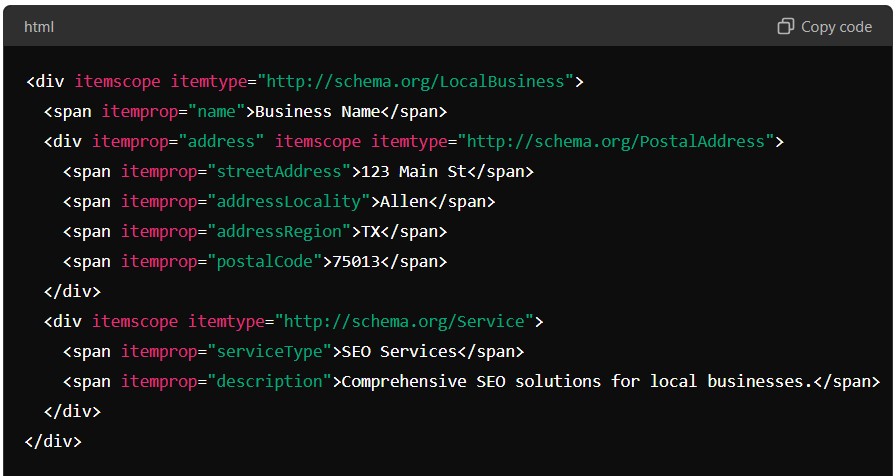Schema markup is a powerful tool for improving your website’s search engine optimization (SEO). By adding structured data to your HTML, you can help search engines understand the content of your pages better, leading to enhanced visibility in search results. This article will guide you through the steps of using schema markup to boost your SEO, with detailed strategies and practical tips.
Understanding Schema Markup

Schema markup, also known as structured data, is a code that you can add to your website’s HTML to provide additional information about your content to search engines. This helps search engines understand the context and purpose of your content, which can lead to better visibility in search results.
What is Schema Markup?
Schema markup is a form of microdata that creates an enhanced description, or rich snippet, that appears in search results. For example, if you own a restaurant, you can use schema markup to provide details such as your location, menu, and reviews directly in the search results. This can make your listing more attractive to users and increase your click-through rate (CTR).
Types of Schema Markup
There are various types of schema markup, including:
- Article: Used for news articles, blog posts, and similar content.
- Local Business: Ideal for businesses with a physical location, such as restaurants, stores, or SEO services Allen TX.
- Product: Provides information about products, including price, availability, and reviews.
- Recipe: Useful for food-related content, offering details like ingredients, cooking time, and nutritional information.
- Event: Highlights details about events, such as dates, locations, and ticket information.
Understanding the different types of schema markup can help you choose the most appropriate one for your content.
Benefits of Schema Markup
Using schema markup offers several benefits:
- Enhanced Search Results: Rich snippets make your listing stand out in search results, which can increase your CTR.
- Better SEO: Schema markup can improve your search engine rankings by helping search engines understand your content better.
- Improved User Experience: Providing detailed information directly in search results can enhance the user experience and drive more qualified traffic to your site.
By leveraging these benefits, you can significantly enhance your SEO strategy. Keyword research is essential for identifying the most relevant schema markup for your content.
Implementing Schema Markup
Implementing schema markup on your website can seem daunting, but with the right approach, it can be straightforward. Here are the steps to get started.
Using Google’s Structured Data Markup Helper
Google’s Structured Data Markup Helper is a tool that makes it easy to add schema markup to your website. Here’s how to use it:
- Choose Data Type: Select the type of data you want to mark up (e.g., articles, local businesses, products).
- Highlight and Tag: Highlight the relevant sections of your webpage and tag them with the appropriate schema markup.
- Generate HTML: The tool will generate the HTML with the schema markup, which you can then add to your website.
This method is user-friendly and doesn’t require extensive coding knowledge, making it accessible for beginners.
Manually Adding Schema Markup
For those comfortable with HTML, manually adding schema markup can offer more control. Here’s a basic example for adding schema markup to a product page:

This code snippet provides structured data for a product, including its name, description, price, and availability.
Testing and Validating Schema Markup
After implementing schema markup, it’s essential to test and validate it to ensure it works correctly. Google’s Structured Data Testing Tool allows you to input your URL or code snippet to check for errors and see how your rich snippets will appear in search results.
Regularly testing and validating your schema markup helps maintain its effectiveness and ensures that search engines can correctly interpret your structured data.
Advanced Strategies for Schema Markup
Once you’ve mastered the basics of schema markup, you can explore advanced strategies to further enhance your SEO.
Combining Schema Markup Types
Combining multiple types of schema markup on a single page can provide comprehensive information to search engines. For example, a local business page for SEO services Allen TX might include both Local Business and Service schema markups to highlight business details and specific services offered.
Here’s an example of combining schema types:

This combination helps search engines understand both the location and the services offered by the business.
Leveraging Schema Markup for Voice Search
With the rise of voice search, optimizing your content for voice queries is becoming increasingly important. Schema markup can enhance your voice search optimization by providing clear and concise information that voice assistants can easily interpret.
Focus on using schema markup to highlight FAQs, how-to guides, and other content formats commonly used in voice search. This can improve your chances of being featured in voice search results and increase your visibility.
Monitoring Schema Markup Performance
To ensure that your schema markup efforts are effective, it’s crucial to monitor their performance. Use tools like Google Search Console to track impressions, clicks, and CTR for pages with rich snippets. This data can help you identify what’s working and make necessary adjustments to your schema markup strategy.
Regular monitoring and analysis ensure that your schema markup continues to provide value and supports your overall SEO goals.
Final Wording
Implementing schema markup is a powerful way to enhance your website’s SEO and improve visibility in search results. By understanding the different types of schema markup, using tools like Google’s Structured Data Markup Helper, and exploring advanced strategies, you can leverage this tool to its full potential. Whether you are a local business offering SEO services Allen TX or a global e-commerce site, schema markup can provide significant benefits for your SEO efforts.
Mastering schema markup is not just about adding code to your website; it’s about understanding how to provide search engines with the best possible information about your content. This can lead to better search engine rankings, increased traffic, and improved user experience.
Remember, regular monitoring and validation of your schema markup are essential to ensure its effectiveness. By staying updated with the latest trends and continuously optimizing your structured data, you can maintain a competitive edge in the ever-evolving world of SEO. Keyword research is crucial for identifying the most effective schema types and ensuring your content is optimized for maximum visibility and engagement.
FAQ’s
1. How does schema markup impact my website’s SEO?
Schema markup enhances your website’s SEO by providing search engines with detailed information about your content. This structured data helps search engines understand the context and relevance of your pages, which can lead to improved visibility in search results and higher click-through rates (CTR). Implementing schema markup can result in rich snippets, which make your search listings more attractive to users.
2. Can I add schema markup to my website without coding knowledge?
Yes, you can add schema markup to your website without extensive coding knowledge. Tools like Google’s Structured Data Markup Helper allow you to highlight and tag relevant sections of your webpage, generating the necessary HTML code. This user-friendly approach makes it accessible for beginners to implement schema markup and enhance their SEO efforts.
3. What types of schema markup should I use for my business?
The type of schema markup you should use depends on your business and content. Common types include Local Business, Product, Article, Recipe, and Event schema markup. For example, if you offer SEO services in Allen, TX, using Local Business schema can help highlight your location and services, while Product schema can be used to provide detailed information about your offerings.
4. How can I test if my schema markup is working correctly?
You can test your schema markup using Google’s Structured Data Testing Tool. This tool allows you to input your URL or code snippet to check for errors and see how your rich snippets will appear in search results. Regular testing and validation ensure that your schema markup is correctly implemented and effective in improving your SEO.
5. Can schema markup help with voice search optimization?
Yes, schema markup can significantly enhance voice search optimization. By providing clear and concise information that voice assistants can easily interpret, schema markup makes your content more likely to be featured in voice search results. Focus on using schema markup for FAQs, how-to guides, and other content formats commonly used in voice search queries.







